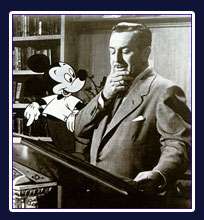
Walt and Mickey
Walt Disney arrived in California in the summer of 1923 with a lot of hopes but little else. He had made a cartoon in Kansas City about a little girl in a cartoon world, called Alice’s Wonderland, and he decided that he could use it as his “pilot” film to sell a series of these Alice Comedies to a distributor. Soon after arriving in California, he was successful. A distributor in New York, M. J. Winkler, contracted to distribute the Alice Comedies on October 16, 1923, and this date became the start of the Disney company. Originally known as the Disney Brothers Cartoon Studio, with Walt Disney and his brother, Roy, as equal partners, the company soon changed its name, at Roy’s suggestion, to the Walt Disney Studio.
Walt Disney made his Alice Comedies for four years, but in 1927, he decided to move instead to an all-cartoon series. To star in this new series, he created a character named Oswald the Lucky Rabbit. Within a year, Walt made 26 of these Oswald cartoons, but when he tried to get some additional money from his distributor for a second year of the cartoons, he found out that the distributor had gone behind his back and signed up almost all of his animators, hoping to make the Oswald cartoons in his own studio for less money without Walt Disney. On rereading his contract, Walt realized that he did not own the rights to Oswald – the distributor did. It was a painful lesson for the young cartoon producer to learn. From then on, he saw to it that he owned everything that he made.
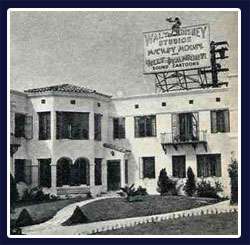
Disney Studio
The original Disney Studio had been in the back half of a real estate office on Kingswell Avenue in Hollywood, but soon Walt had enough money to move next door and rent a whole store for his studio. That small studio was sufficient for a couple of years, but the company eventually outgrew it and Walt had to look elsewhere. He found an ideal piece of property on Hyperion Avenue in Hollywood, built a studio, and in 1926 moved his staff to the new facility.
It was at the Hyperion Studio, after the loss of Oswald, that Walt had to come up with a new character, and that character was Mickey Mouse. With his chief animator, Ub Iwerks, Walt designed the famous mouse and gave him a personality that endeared him to all. Ub animated two Mickey Mouse cartoons, but Walt was unable to sell them because they were silent films, and sound was revolutionizing the movie industry. So, they made a third Mickey Mouse cartoon, this time with fully synchronized sound, and Steamboat Willie opened to rave reviews at the Colony Theater in New York November 18, 1928. A cartoon star, Mickey Mouse, was born. The new character was immediately popular, and a lengthy series of Mickey Mouse cartoons followed.
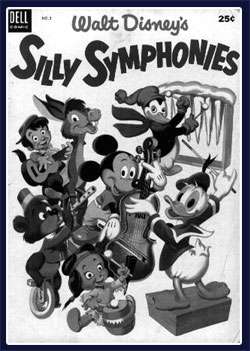
Silly Symphonies
Not one to rest on his laurels, Walt Disney soon produced another series-the Silly Symphonies-to go with the Mickey series. It featured different casts of characters in each film and enabled the animators to experiment with stories that relied less on the gags and quick humor of the Mickey cartoons and more on mood, emotion, and musical themes. Eventually the Silly Symphonies turned into the training ground for all Disney artists as they prepared for the advent of animated feature films. Flowers and Trees, a Silly Symphony and the first full – color cartoon, won the Academy Award for Best Cartoon for 1932, the first year that the Academy offered such a category. For the rest of that decade, a Disney cartoon won the Oscar every year.
While the cartoons were gaining popularity in movie houses, the Disney staff found that merchandising the characters was an additional source of revenue. A man in New York offered Walt $300 for the license to put Mickey Mouse on some pencil tablets he was manufacturing. Walt Disney needed the $300, so he said okay. That was the start of Disney merchandising. Soon there were Mickey Mouse dolls, dishes, toothbrushes, radios, figurines – almost everything you could think of bore Mickey’s likeness. The first Mickey Mouse book was published in 1930, as was the first Mickey Mouse newspaper comic strip.
In 1934, Walt Disney informed his animators one night that they were going to make an animated feature film, and then he told them the story of Snow White and the Seven Dwarfs. There were some skeptics in the group, but before long everyone had caught Walt’s enthusiasm, and work began in earnest. It took three years, but at Christmas time, 1937, the film was finished, and it was a spectacular hit. Snow White soon became the highest grossing film of all time, a record it held until it was surpassed by Gone With the Wind. Now Walt Disney’s studio was on a firmer footing. The short cartoons paid the bills, but Walt knew that future profits would come from feature films.
Work immediately began on other feature projects, but just as things were looking rosy, along came World War II. The next two features, Pinocchio and Fantasia, were released in 1940. They were technical masterpieces, but their costs were too high for a company losing most of its foreign markets because of the war. Dumbo was made in 1941 on a very limited budget, but Bambi, in 1942, was another expensive film, and caused the studio to retrench. It would be many years before animated features of the highest caliber could be put into production.
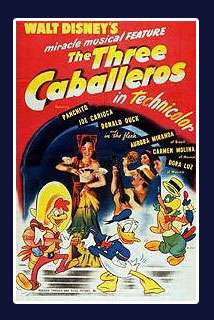
Three Caballeros
During the war, Walt Disney made two films in South America, Saludos Amigos and The Three Caballeros, at the request of the State Department. His studio concentrated on making propaganda and training films for the military. When the war ended, it was difficult for the Disney Studio to regain its pre-war footing. Several years went by with the release of “package” features-films such as Make Mine Music and Melody Time, containing groups of short cartoons packaged together. Walt also moved into live action production with Song of the South and So Dear to My Heart, but because audiences expected animation from Walt Disney, these films included animated segments. Walt opened some new doors by beginning the award-winning True-Life Adventure series featuring nature photography of a style never seen before.
1950 saw big successes at Disney – the first completely live action film, Treasure Island, the return to classic animated features with Cinderella and the first Disney television show at Christmas time. The company was moving forward again. After two Christmas specials, Walt Disney went onto television in a big way in 1954 with the beginning of the Disneyland anthology series. This series eventually would run on all three networks – and go through six title changes, but it remained on the air for 29 years, making it the longest-running prime-time television series ever. The Mickey Mouse Club, one of television’s most popular children’s series, debuted in 1955 – and made stars of a group of talented Mouseketeers.
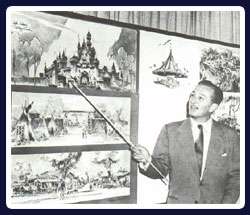
Walt Disney showing his plans for Disneyland
Disney was never satisfied with what he had already accomplished. As his motion pictures and television programs became successful, he felt a desire to branch out. One area that intrigued him was amusement parks. As a father, he had taken his two young daughters to zoos, carnivals, and other entertainment enterprises, but he always ended up sitting on the bench as they rode the merry-go-round and had all the fun. He felt that there should be a park where parents and children could go and have a good time together. This was the genesis of Disneyland. After several years of planning and construction, the new park opened July 17, 1955.
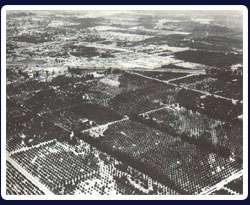
The Site for Disneyland
Disneyland was a totally new kind of park. Observers coined the term “theme park,” but even that does not seem to do Disneyland justice. It has been used as a pattern for every amusement park built since its opening, becoming internationally famous, and attracting hundreds of millions of visitors. Walt said that Disneyland would never be completed as long as there was imagination left in the world, and that statement remains true today. New attractions are added regularly, and Disneyland still is as popular as it was in 1955.
The 1950s saw the release of the classic 20,000 Leagues Under the Sea, the first in a series of wacky comedies The Shaggy Dog, and a popular TV series about the legendary hero, Zorro. In the 1960s came Audio – Animatronics, pioneered with the Enchanted Tiki Room at Disneyland and then four shows at the 1964 New York World’s Fair, and Mary Poppins, perhaps the culmination of all Walt Disney had learned during his long movie – making career. But the ’60s also brought the end of an era: Walt Disney died December 15, 1966.
Plans that Walt left behind carried the company for a number of years under the supervision of Roy Disney. The Jungle Book in 1967 and The Aristocats in 1970 showed that the company could still make animated classics, and The Love Bug in 1969 was the highest grossing film of the year. Disney got into educational films and materials in a big way with the start of an educational subsidiary in 1969.
After the success of Disneyland, it was only natural for Walt to consider another park on the East Coast. Prior to his death the company purchased land in Florida, and the Walt Disney World project, located on some 28,000 acres near Orlando, was announced. It opened October 1, 1971. In Florida, the company had the space it lacked in California. Finally there was room to create a destination resort, unencumbered by the urban sprawl that had grown up around Disneyland. Walt Disney World would include not only a Magic Kingdom theme park like Disneyland but also hotels, campgrounds, golf courses, and shopping villages. It did not take long for Walt Disney World to become the premier vacation destination in the world.
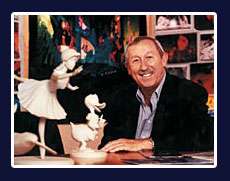
Roy O. Disney
Roy O. Disney, who after Walt’s death oversaw the building and financing of Walt Disney World, died late in 1971, and for the next decade the company was led by a team including Card Walker, Donn Tatum, and Ron Miller – all originally trained by the Disney brothers. One of Walt Disney’s last plans had been for the Experimental Prototype Community of Tomorrow, or EPCOT, as he called it. While he died before the plans could be refined, they were brought out again in a few years, and in 1979 ground was broken for the new park in Florida. Epcot Center, a combination of Future World and World Showcase representing an investment of over a billion dollars, opened to great acclaim October 1, 1982.
WED Enterprises (later renamed Walt Disney Imagineering), the design and development division for the parks, had several projects in the works during the early 1980s. In addition to designing Epcot, it was hard at work on plans for Tokyo Disneyland, the first foreign Disney park. Tokyo Disneyland opened April 15, 1983, and was an immediate success in a country that had always loved anything Disney. Now that the Japanese had their own Disneyland, they flocked to it in increasing numbers.
Moviemaking also was changing in America in the early 1980s. Audiences were diminishing for the family films that had been the mainstay of the company for many years, and Disney was not meeting the competition for films that attracted the huge teenage and adult market. To reverse that trend, Disney established a new label, Touchstone Pictures, with the release of Splash in 1984. At the same time, because of the widespread perception that Disney stock was undervalued relative to the company’s assets, two “corporate raiders” attempted to take over Disney. The efforts to keep the company from being broken up ended when Michael Eisner and Frank Wells became chairman and president, respectively.
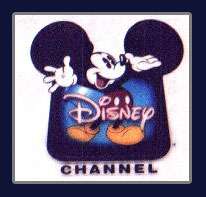
Disney Channel
The new management team immediately saw ways for Disney to maximize its assets. The company had left network television in 1983 to prepare for the launch of a cable network, The Disney Channel. While the pay-TV service was successful, Eisner and Wells felt Disney should have a strong network presence as well, so in 1985 Disney’s Touchstone division began the immensely successful Golden Girls, followed in 1986 by a return to Sunday night television with the Disney Sunday Movie (later The Magical World of Disney). Films from the Disney library were selected for the syndication market, and some of the classic animated films were released on video cassette. Using the sell- through technique, Disney classics soon reached the top of the all-time best seller lists.
At Disneyland, new collaborations with filmmakers George Lucas and Francis Coppola brought Captain EO and Star Tours to the park, and Splash Mountain opened in 1989. Disney’s Grand Floridian Beach and Caribbean Beach Resorts opened at Walt Disney World in 1988, and three new gated attractions opened in 1989: the Disney/MGM Studios Theme Park, Pleasure Island, and Typhoon Lagoon. More resort hotels opened in 1990 and 1991.
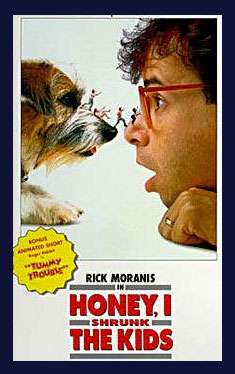
Honey, I Shrunk the Kids
Filmmaking hit new heights in 1988 as Disney for the first time led Hollywood studios in box-office gross. Who Framed Roger Rabbit, Good Morning, Vietnam, Three Men and a Baby, and later, Honey, I Shrunk the Kids, Dick Tracy, Pretty Woman, and Sister Act passed the $100 million milestone. Disney moved into new areas by starting Hollywood Pictures, and acquiring the Wrather Corp. (owner of the Disneyland Hotel) and television station KHJ (Los Angeles), which was renamed KCAL. In merchandising, Disney purchased Childcraft and opened over 200 highly successful and profitable Disney Stores.
Disney animation began reaching even greater audiences, with The Little Mermaid being topped by Beauty and the Beast which was in turn topped by Aladdin (1992). Hollywood Records was formed to offer a wide selection of recordings ranging from rap to movie soundtracks. New television shows, such as Live With Regis and Kathy Lee, Empty Nest, Dinosaurs, and Home Improvement, expanded Disney’s television base. For the first time, Disney moved into publishing, forming Hyperion Books, Hyperion Books for Children, and Disney Press, which released books on Disney and non-Disney subjects. In 1991, Disney purchased Discover magazine, the leading consumer science monthly. As a totally new venture, Disney was awarded in 1993 the franchise for a National Hockey League team, the Mighty Ducks of Anaheim.
Over in France, the park, now known as Disneyland Paris opened on April 12, 1992. Eagerly anticipated, the beautifully designed park attracted almost 11 million visitors during its first year. Disneyland Paris is complemented by six uniquely designed resort hotels and a campground. Dixie Landings and Port Orleans, and a well-received Disney Vacation Club enlarged lodging possibilities at the Walt Disney World Resort, and Mickey’s Toontown helped increase attendance at Disneyland after its 1993 debut. Walt Disney World opened the All-Star Resorts, Wilderness Lodge, the Twilight Zone Tower of Terror, and Blizzard Beach, and redesigned Tomorrowland in the Magic Kingdom, and at Disneyland, the opening of the Indiana Jones Adventure increased the number of visitors.
The Disney success with animated films continued in 1994 with The Lion King, which soon became one of the highest-grossing films of all-time. It was followed by Pocahontas in 1995 and The Hunchback of Notre Dame in 1996. Toy Story pioneered computer-animation techniques. Disney also continued its strong presence in children’s animated programs for television, with Aladdin and Gargoyles receiving high ratings.
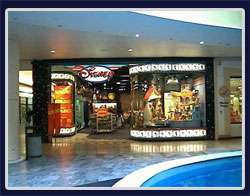
Disney Store
By 1996, there were more than 450 Disney Stores worldwide. In Florida, the first home sites were sold in the new city of Celebration, located next to Walt Disney World. Eventually, 20,000 people will call Celebration their home. Arrangements have been made for Disney to purchase 25% of the California Angels baseball team, with the balance to be acquired after the death of present owner Gene Autry. Early in 1996, Disney completed its acquisition of Capital Cities/ABC. The $19 billion transaction, second-largest in U.S. history, brings the country’s top television network to Disney, in addition to 10 TV stations, 21 radio stations, seven daily newspapers, and ownership positions in four cable networks.
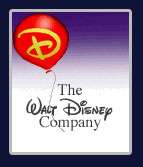
Disney Company
For more than seven decades, The Walt Disney Company has succeeded in making its name preeminent in the field of family entertainment. From humble beginnings as a cartoon studio in the 1920s to today’s major corporation, it continues its mandate of providing quality entertainment for the entire family.
